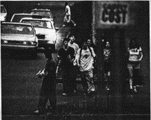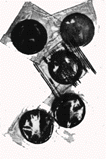|
Support CatholicBoy.com! |
Kids Will Be KidsDisney disowned its Kids rather than suffer the political fallout. Punk poet Jim Carroll, author of The Basketball Diaries, explains why we need the jolt packed by this latest contribution to bad-boy art. It seems a grand mistake, almost aesthetically shameful, to play the game of deciphering moral intent in Kids, the controversial film by renegade photographer Larry Clark, which will have finally reached all its intended theaters by mid- September. The movie seems to exist without ulterior motive--partly due to its documentary style, partly because of the unique vision shared by Clark and his collaborator, Harmony Korine. "I always wanted to make the teenage movie that I felt America never Clark has said. "The great American teenage movie, like the 'great American novel.'" Kids indeed is masterful. The irony is that, for political reasons, the movie will probably have been interpreted by every pundit and hack from New Hampshire to the Senate floor, Disney fled the project early because of the probability of an NC-17 rating--the executives headed downstream in a flotilla of birch-bark canoes. Its subsidiary Miramax, the film's owner, stuck by it through the heat, but still found some margin of distance by creating a separate company for its distribution. And if Robert Dole found True Romance disturbing, he would do well to have medical technicians standing by for Kids. After all, kids are our future.  Fast lane: The kids in Kids, the film by outlaw photographer Larry Clark. Of course, that's the problem. It's not the sex scenes, or the drugs, or even the single scene of ultra-violence (though it is one of the most shocking displays of brutality I've ever witnessed onscreen); it is the age of the performers that's got everyone so wigged out. The characters (all played by nonprofessionals) range in age from about 10 to 16. At the press conference after the film's debut at Cannes, reporters blistered the director and writer for exploitation, objectification (a horrid sin!) and gross exaggeration. The film deals with the subculture of skateboarders who hang around New York City's Washington Square Park by day and party by night, either at a disco or the apartment of anyone whose parents happen to be out of town. They eschew hard drugs, opting for cigar-sized joints and "forties" of malt liquor. These are real kids without any traces of Hollywood's nooky standards. They are horny and vital and have no need for the kink and psychological paraphernalia of adult intimacy. No need for $500 worth of lace-shrouded fantasy from Victoria's Secret, no need for acrobatics in whirlpools shaped like champagne glasses. Which is not to say there is no quirkiness among the characters' sexual wants. The entire appetite of Telly, the male lead, is defined by a very devious fixation. But how exaggerated are these kids? Passing the other day through Washington Square Park, where much of the film takes place, I saw four drug buys go down--and I was in a hurry. Teen promiscuity has become a cottage industry for talk shows such as Ricki Lake, Jenny Jones et al., where 15-year-old girls compete to be the one who has humped the most guys since age 12. The furor over the age of the kids in the film, though, provokes a mystifying question that recurs from one generation to the next. At what point, and by what experience, do we adults find ourselves so insulated by the artifice and purblind world-weariness of society that we not only lose the vision and freedom of youth--and, admittedly, its recklessness and misjudgments--but, further, find ourselves so fearful of youth and its particular subcultures? What is the threshold of this change? It seems to seize individuals at various ages and to widely different extents, but very few do not yield to it in one form or another. Kafka saw it as a shell, which, in The Metamorphosis, overcame and transformed Gregor in a single night. In The Death of Ivan Ilyich, Tolstoy describes how youth's radiance is weakened by quotidian repetitions, ossifying into a husk, repelling tolerance of anything new. The shell is strong in these times, hardened by the creature comforts of technology. We drive to work within the still confines of our cars. We work inside high-rises of black glass, which literally absorb sunlight. We relax later in front of tubes that slyly suck the life source from us as they harden the husk. Nothing penetrates this encasement like the exotic, erotic energy of youth. It is otherworldly to those confined, and its threat is massive. This is the power behind Kids, and the fear it evokes. No other film in the history of cinema is more honest to the pure energy of youth culture. Let's face it: Youth really hasn't changed that much since the mid-'60s and the so-called counterculture revolution. That means the majority of the fearful shell-encased out there had a youth that was not all that different in its decadence than that portrayed in Kids. This being the case, from one generation to the next, why is it so difficult for so many to realize that 95 percent of today's kids (including the cast of the film) will, sometime over the next decade, recede deeply within their own shells? Some will End page 230
 One couldn't do better than Larry Clark as an example of a man without a shell, whose radiance of vision at 52 years of age has not diminished. Perhaps he has never truly been socialized: in part because of his obsession as an artist, in part because of his literally outlaw persona. He served three years in prison for shooting someone in a rather heated dispute back in the mid '70s in Tulsa. But it is the screenwriter Korine, at 20 still a kid himself, who interests me more. I began hearing about him two years ago. People on the downtown streets started approaching me and telling me about this kid--apparently a fan of my work--who was going around the art scene telling folks that I attended his birth, circa 1974, in some eucalyptus grove in the northern California town of Bolinas. The fact is, I was indeed living at that time in BoImas, a heavy-duty hippie enclave consisting of a mesa, a bar, a laundromat and an agate-strewn beach on the Pacific. According to this kid's own lore, not only had I attended this birth al fresco, but upon Korine's emergence, I had ceremoniously cut the cord between his mother and himself. I had to really strain my memory on this claim. Then began pleas, from a mutual friend of the kid's parents and mine, to read his work. I begged off; but about a year and a half ago I received a screenplay in the mail from producer Cary Woods. It was titled Kids, and beneath that was handwritten "By Harmony Korine, the Famous Writer." The guy from the nativity scene, I realized. I read the script in one sitting. It blew me away. To possess such natural and yet refined talent at 18 (which is when he wrote the script) was extraordinary, of course. The little weasel was right, I thought: I had cut his cord. Suddenly the whole scene was quite vivid in my memory. We began an acquaintanceship by phone; then, one night on the set of a film I was involved with, he came up and introduced himself in person. He didn't look a day over 14 with his mop haircut. He was short and subdued. His face bore the sharp features of the diverse lineage he has claimed to me. His great-grand mother was, apparently, a shaman of the Zuni Indian tribe. His mother was the free-spirited offspring of Norwegian and Mexican parents, her youth spent in the South among a fundamentalist Christian sect. His father, born into a secular Jewish family of 14 siblings, pursued a career in acting in his early twenties, doing mainly summer stock. But the strangest part of Korine's background is his claim, in his official Miramax biography, that Huntz Hall, one of the stars of the Bowery Boys movies, is his uncle. Most press persons consider this one of Korine's typical ruses, but I have reason to give him the benefit of the doubt . . . somewhat. In 1981, on a promotional tour of Europe for a record album, I actually met Hall in a hotel bar and ended up in conversation. We were discussing a Jorge Luis Borges story about a young insomniac cursed with the inability to forget anything, when Hall told me: "I have a young nephew much like that. He is only five or six years old, and he seemingly can recite the dialogue to every Bowery Boys film verbatim. He gets on the phone with me and goes on and on. Last call it was Angels With Dirty Faces." "'Rocky dies yellow,'" I shot back. "There you go," said Huntz. "But no kidding, the child is amazing... or autistic." Could this mnemonic nephew, whom Huntz Hall spoke so fondly of that night in Paris, be Harmony Korine? Why not? Korine just doesn't buy into the system; by his words it is obvious. Perhaps this is why he amuses himself by constantly reinventing his life. He is one of those select few who will move smoothly from one generation of kids to the next, knowing that the only difference is fashion. That's not completely true, of course. The violence of kids today, both quantitatively and qualitatively, has enormously increased in ration beyond that of sex and drugs. (The movie's most brutal scene was inspired by an all-too-real event Korine witnessed no more than 20 yards from where it was filmed.) The reasons for the increased violence have been scrutinized ad nauseam, and I both don't understand them and understand them too well. For enormous sectors of the youth population, parental guidance is either nil or manifested by abuse. For too many kids, nobody's home. And it's going to get worse before getting better A friend who works as a substitute teacher in schools for "troubled" kids gave some eight- and and nine-year-olds clay to mold. Of the nine students, eight constructed guns (mainly Tec-9s). The remaining kid was slightly more imaginative: He fashioned his clay into a beeper. In the '60s and '?Os, the world was still slow enough for many kids to recognize their own misjudgments and recover. But what will become of those kids that are economically disenfranchised from the high-speed technological future? They'll either riot and loot in cyberspace or die of nonexposure in some virtual ditch right off the main hyper-drag. Their radiance will be perverted, turned in on itself. As society speeds along at a vertiginous pace, moral boundaries become so subjective that they are no longer binding. Throughout Kids, the lead female character, Jennie (played by Chloe Sevigny), wanders trancelike on a quest to find Telly, for a purpose that is never made entirely clear, nor resolved. It is unlikely that she herself knows. And it's doubtful that we, the audience, know. The kids themselves sure don't have a clue. It's just too fast out there these days.
Enclosed in their husks and behind the many masks of the system and its time, not many adults will truly allow the freshness of Kids to enter on its own terms, without their own moral impositions. The best one can do, after seeing this film, is to sincerely try to answer the question posed by Casper, one of the most zonked-out characters, in Kids's final line: "Jesus Christ, what happened?" © 1995 Jim Carroll Read the transcript of Harmony Korine's chat on barnesandnoble.com
|
Site Map | Contact Info | About this site | About the webmaster
The Jim Carroll Website © 1996-2025 Cassie Carter